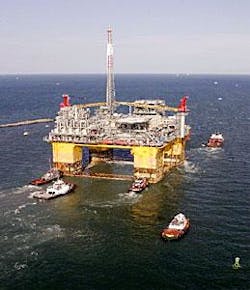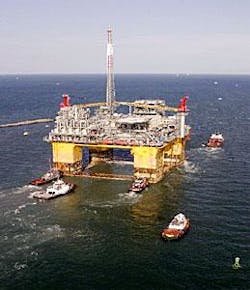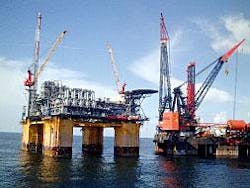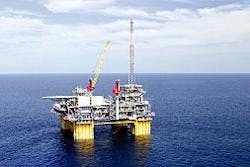Hurricane Claudette and strong loop currents affected installation of the Na Kika semisubmersible production unit in the Gulf of Mexico.
null
Shell Exploration & Production Co. said the hurricane caused a 6-day delay in the installation and that earlier the loop currents in the area had caused placing the unit into a holding pattern for several days during its 503 nautical miles tow from the Kiewit Offshore Services fabrication yard in Ingleside, Tex., near Corpus Christi, to Mississippi Canyon Block 474.
The unit began being towed on June 28, arriving on location on July 9 after traveling 503 nautical miles.
Once the loop currents subsided, Heerema Group's SSIV Balder J-lay/heavy lift vessel began installation and mooring, connecting the last of the 16 mooring lines on Aug. 1, 2003, according to Shell.
Na Kika development
The Na Kika floating production unit is about 140 miles southeast of New Orleans (Fig. 3) and will handle production from five subsea developed fields: Kepler, Ariel, Fourier, Herschel, and E. Anstey that are in 5,800-7,000 ft of water.
The unit has separation, dehydration, and treatment facilities for processing 425 MMcfd of gas, 110,000 bo/d, and 7,000 bw/d.
null
Shell has a 50% interest in the floating host facilities and Kepler, Ariel, Fourier, and Herschel fields, with the other 50% interest held by BP PLC. Shell has a 37.5% interest in East Anstey field, with BP PLC holding the remaining 62.5%.
A sixth field, Coulomb, 100% Shell owned, is in 7,600 ft of water and will be tied back to Na Kika as production capacity becomes available.
Ten development wells, competed earlier in 2003 will produce the five fields.
The production will travel through a 29-mile north oil loop, consisting of 10 and 16-in. pipe-in-pipe insulated flowlines, a 26-mile south oil loop, consisting of 8 and 12-in. pipe-in-pipe insulated flowlines, and a 32-mile south gas loop, consisting of 8-in. uninsulated flowlines.
Kepler, Ariel, and Herschel primarily will produce oil, while Fourier, East Anstey and Coulomb will produce primarily gas.
Shell expects first production to flow to the unit in late in 2003, and it estimates an ultimate recovery of 300 million boe from the fields.
Shell is pre-development operator of the Na Kika development, responsible for design, fabrication, and installation of the floating host facility and subsea production systems, as well as drilling and completion of the 10 development wells.
null
BP is post-production operator, responsible for operations on the host facility and surveillance of the satellite subsea fields.
Shell estimates total project cost is about $1.4 billion, excluding lease costs and Coulomb development.
About 30% of the costs are associated with fabrication and installation of the host facility, 20% of the costs are associated with fabrication and installation of subsea components, 25% are associated with drilling and completion of the wells, 15% are design and project management costs, and 10% are associated with fabrication and installation of the export pipelines.
The topsides and hull were fabricated and mated at the Hyundai Heavy Industries Co. Ltd. yard in Ulsan, South Korea (OGJ Jan. 6, 2003, p. 46).




